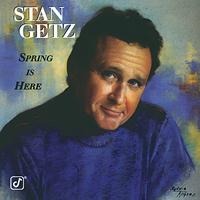Getz Live Session From 1981 on Double 45rpm Vinyl
Recorded in May, 1981 but not issued until Getz's passing a decade later in 1991, this live recording at San Francisco's Keystone Korner is a “volume 2” to the previously issued The Dolphin (Concord CCD 4158).
Backed by California jazz veterans Lou Levy and Monty Budwig, plus drummer Victor Lewis who'd joined up with Getz the year before and remained with him until the tenor great's death, Getz demonstrates that his playing remained vital and his big, breathy Prez -influenced sound hadn't left him.
This late phase in Getz's career may be more of a denouement than a vital chapter, but the playing all around is so fine, and the recording so big and clear, the listening pleasure is enormous.
Getz began in big bands and become a star while with Woody Herman. He went on to form his own quartet in 1950, a group that spearheaded the “West Coast” jazz movement and issued a series of 78s later transferred to LP on the Roost label.
Getz went on to Verve where he issued a long string of remarkable albums. A drug problem caused him to leave America for a few years, but when he returned in 1961, he began actively touring around the world and he recorded some stunning albums such as the moody Focus (Verve V-6 8412) composed and arranged by Eddie Sauter.
A few years later Getz became an unlikely pop star of sorts releasing some of the most famous and popular jazz albums ever, including Jazz Samba with Charlie Byrd and Getz/Gilberto, which included “The Girl From Ipanema.”
Anyone who remembers the period knows that Stan Getz almost single-handedly introduced Brazilian music to America by popularizing “bossa nova” much as Herb Alpert did likewise with his blend of Mexican Mariachi music and Paul Simon did with his adaptations of Peruvian and other folk based music of the Southern Hemisphere. Is it just coincidental that all three are Jewish? Just asking. I'm one. I know, I'm a self-loathing Jew.
Getz's gear-shifting into bossa nova and his becoming a kind of pop star was accomplished without his losing credibility as one of jazz's greatest tenor sax players. That's probably because he remained true to his craft and issued legitimate jazz albums that just happened to catch the public's fancy. His teaming up with Antonio Carlos Jobim, Joao Gilberto and Astrud Gilberto, the hottest jazz stars in Brazil, didn't hurt the cause either.
Getz even recorded an album of Bacharach and David tunes (What The World Needs Now/Stan Getz Plays Bacharach and David [Verve V6-8752]) in 1967, and if that was perhaps dipping dangerously into pop, it was way hip way before its time and the arrangements by Richard Evans hold up pretty well today.
So Getz has done it all; big band, be-bop, bossa nova, Bacharach-David and I'm sure plenty of stuff not beginning with the letter “B.”
On this posthumous album the cover portrait artist has Getz trading in his black hipster/be-bop suit and skinny tie and white shirt and the accompanying hard-edged look for a turtle-neck sweater and a nice guy grin. I hate when that happens. It always does though, as guys from Bowie, to Gene Clark to Getz trade in their mystery for a “Mr. Nice Guy” image. Oh well.
While the music in the grooves is strictly standards, the playing is anything but from the quartet of veterans. Getz's lyricism and colorful phrasing are in full flower in front of the supportive rhythm section. No analysis is required. This is straight ahead jazz, impeccably played that goes down easy like good single-malt. It's easy to listent to, but not at all easy listening if you know what I mean. The late Levy, a veteran live jazz and studio session-man, has a long history backing female singers (Ella, Anita O'Day, Peggy Lee, and June Christy among them), so no surprise he's equally adept behind the tenor man, and when given some solo time he makes the most of it.
The recording is closely miked to the point where little of the club's ambience comes through, so don't expect a Village Vanguard-like experience. You will hear a plate drop and crash to the ground in the middle of “Easy Living,” but otherwise aside from applause after some great solos and when songs conclude, there's little to suggest a live venue.
Getz's sax sounds as if a bit of tasteful reverb has been added, though it does make it seem as if he's playing in a slightly different environment. I wouldn't call this an “audiophile” recording because of the closeness of the mikes, the questionable reverb and the somewhat unrealistic mix, but the instruments themselves are extremely well recorded and it's especially pleasurable to get such an intimate, unfiltered sonic portrait of the great Stan Getz. Includes heartfelt liner notes by son Steve Getz written December, 1991.
- Log in or register to post comments



